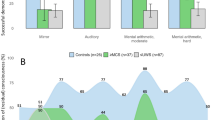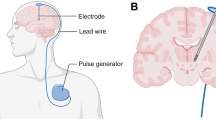Abstract
Deep brain stimulation (DBS) of the subthalamic nucleus (STN) is widely used in the treatment of Parkinson’s disease. DBS surgery is usually performed with the patient under local anesthesia (LA). However, a number of patients do not tolerate LA due to anxiety or severe pain. These patients require surgery under sedation or general anesthesia. Unfortunately, anesthetic drugs interfere with the intraoperative microelectrode recordings. A debate regarding the usefulness of sedation or general anesthesia during DBS surgery is still in progress. In this study, we evaluated whether the differences in anesthetic methods affect STN single-unit activity and movement symptoms of Parkinson’s disease. Eight patients underwent surgery to implant bilateral STN DBS electrodes. Our study compares STN single-unit activity under both LA and monitored anesthesia care (MAC) in the same patients as well as movement symptoms of Parkinson’s disease. The primary results revealed no significant difference in the mean firing rate of STN single-unit activity under LA and MAC. However, there were differences in the spike characteristics and firing patterns of STN activity between the two anesthetic methods. These findings contribute valuable insight into the effects of different anesthetic methods on STN single-unit activity for precise electrode localization during DBS surgery.
Similar content being viewed by others
References
Kringelbach, M. L., Jenkinson, N., Owen, S. L., and Aziz, T. Z., “Translational Principles of Deep Brain Stimulation,” Nature Reviews Neuroscience, Vol. 8, No. 8, pp. 623–635, 2007.
Benabid, A. L., Chabardes, S., Mitrofanis, J., and Pollak, P., “Deep Brain Stimulation of the Subthalamic Nucleus for the Treatment of Parkinson's Disease,” The Lancet Neurology, Vol. 8, No. 1, pp. 67–81, 2009.
Hutchison, W., Allan, R., Opitz, H., Levy, R., Dostrovsky, J., et al., “Neurophysiological Identification of the Subthalamic Nucleus in Surgery For Parkinson’s Disease,” Annals of Neurology, Vol. 44, No. 4, pp. 622–628, 1998.
Kim, J. W., Kwon, Y., Ho, Y., Park, S. H., Kim, C. S., et al., “Effects of Medication and Deep Brain Stimulation on Speed and Amplitude are Different between Finger and Forearm in Patient with Parkinson’s Disease,” Int. J. Precis. Eng. Manuf., Vol. 14, No. 7, pp. 1201–1207, 2013.
Counelis, G. J., Simuni, T., Forman, M. S., Jaggi, J. L., Trojanowski, J. Q., et al., “Bilateral Subthalamic Nucleus Deep Brain Stimulation for Advanced PD: Correlation of Intraoperative MER and Postoperative MRI with Neuropathological Findings,” Movement Disorders, Vol. 18, No. 9, pp. 1062–1065, 2003.
Maltête, D., Navarro, S., Welter, M. L., Roche, S., Bonnet, A. M., et al., “Subthalamic Stimulation in Parkinson Disease: With or without Anesthesia?” Archives of Neurology, Vol. 61, No. 3, pp. 390–392, 2004.
Hertel, F., Züchner, M., Weimar, I., Gemmar, P., Noll, B., et al., “Implantation of Electrodes for Deep Brain Stimulation of the Subthalamic Nucleus in Advanced Parkinson’s Disease with the Aid of Intraoperative Microrecording under General Anesthesia,” Neurosurgery, Vol. 59, No. 5, Paper No. E1138, 2006.
Sutcliffe, A., Mitchell, R., Gan, Y., Mocroft, A., and Nightingale, P., “General Anaesthesia for Deep Brain Stimulator Electrode Insertion in Parkinson’s Disease,” Acta Neurochirurgica, Vol. 153, No. 3, pp. 621–627, 2011.
Kalenka, A. and Schwarz, A., “Anaesthesia and Parkinson’s Disease: How to Manage with New Therapies?” Current Opinion in Anesthesiology, Vol. 22, No. 3, pp. 419–424, 2009.
Raz, A., Eimerl, D., Zaidel, A., Bergman, H., and Israel, Z., “Propofol Decreases Neuronal Population Spiking Activity in the Subthalamic Nucleus of Parkinsonian Patients,” Anesthesia & Analgesia, Vol. 111, No. 5, pp. 1285–1289, 2010.
Paek, S. H., Kim, H. J., Yoon, J. Y., Heo, J. H., Kim, C., et al., “Fusion Image-Based Programming after Subthalamic Nucleus Deep Brain Stimulation,” World Neurosurgery, Vol. 75, No. 3, pp. 517–524, 2011.
Robin, K., Maurice, N., Degos, B., Deniau, J. M., Martinerie, J., et al., “Assessment of Bursting Activity and Interspike Intervals Variability: A Case Study for Methodological Comparison,” Journal of Neuroscience Methods, Vol. 179, No. 1, pp. 142–149, 2009.
Legendy, C. and Salcman, M., “Bursts and Recurrences of Bursts in the Spike Trains of Spontaneously Active Striate Cortex Neurons,” Journal of Neurophysiology, Vol. 53, No. 4, pp. 926–939, 1985.
Kaneoke, Y. and Vitek, J., “Burst and Oscillation as Disparate Neuronal Properties,” Journal of Neuroscience Methods, Vol. 68, No. 2, pp. 211–223, 1996.
Labarre, D., Meissner, W., and Boraud, T., “Measure of the Regularity of Events in Stochastic Point Processes, Application to Neuron Activity Analysis,” Proc. of the IEEE International Conference on Acoustics, Speech and Signal Processing, pp. 489–492, 2008.
Kim, H. J., Paek, S. H., Kim, J. Y., Lee, J. Y., Lim, Y. H., et al., “Two-Year Follow-Up on the Effect of Unilateral Subthalamic Deep Brain Stimulation in Highly Asymmetric Parkinson’s Disease,” Movement Disorders, Vol. 24, No. 3, pp. 329–335, 2009.
Mai, J. K., Assheuer, J., and Paxinos, G., “Atlas of the Human Brain,” Academic Press San Diego, 1997.
Steigerwald, F., Pötter, M., Herzog, J., Pinsker, M., Kopper, F., et al., “Neuronal Activity of the Human Subthalamic Nucleus in the Parkinsonian and Nonparkinsonian State,” Journal of Neurophysiology, Vol. 100, No. 5, pp. 2515–2524, 2008.
Lettieri, C., Rinaldo, S., Devigili, G., Pauletto, G., Verriello, L., et al., “Deep Brain Stimulation: Subthalamic Nucleus Electrophysiological Activity in Awake and Anesthetized Patients,” Clinical Neurophysiology, Vol. 123, No. 12, pp. 2406–2413, 2012.
Baufreton, J., Zhu, Z. T., Garret, M., Bioulac, B., Johnson, S., et al., “Dopamine Receptors Set the Pattern of Activity Generated in Subthalamic Neurons,” The FASEB Journal, Vol. 19, No. 13, pp. 1771–1777, 2005.
Plenz, D. and Kital, S. T., “A Basal Ganglia Pacemaker Formed by the Subthalamic Nucleus and External Globus Pallidus,” Nature, Vol. 400, No. 6745, pp. 677–682, 1999.
Johnson, S. W., “Rebound Bursts Following Inhibition: How Dopamine Modifies Firing Pattern in Subthalamic Neurons,” Journal of Physiology, Vol. 586, No. 8, p. 2033, 2008.
Henderson, J. M., Jaffe, R. A., and Brock-Utne, J. G., “Human Subthalamic Neuron Spiking Exhibits Subtle Responses to Sedatives,” Anesthesiology, Vol. 115, No. 2, pp. 254–264, 2011.
McCarthy, M. M., Ching, S., Whittington, M. A., and Kopell, N., “Dynamical Changes in Neurological Diseases and Anesthesia,” Current Opinion in Neurobiology, Vol. 22, No. 4, pp. 693–703, 2012.
Author information
Authors and Affiliations
Corresponding authors
Rights and permissions
About this article
Cite this article
Park, E., Heo, M.S., Lim, Y.H. et al. The effects of different anesthetic methods on neuronal activity and movement symptoms of Parkinson’s disease. Int. J. Precis. Eng. Manuf. 16, 573–579 (2015). https://doi.org/10.1007/s12541-015-0077-2
Received:
Revised:
Accepted:
Published:
Issue Date:
DOI: https://doi.org/10.1007/s12541-015-0077-2




